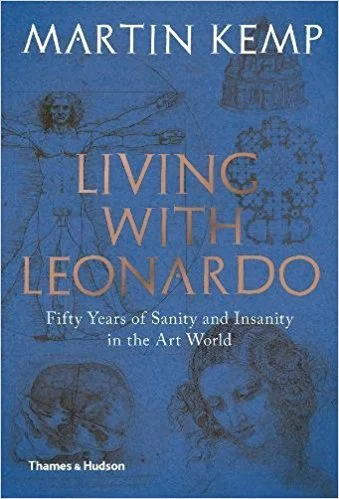Living with Leonardo by Martin Kemp
/Living with Leonardo: Fifty Years of Sanity and Insanity in the Art World and Beyond
by Martin Kemp
Thames & Hudson, 2018
Martin Kemp, Emeritus Oxford history professor and long-time expert on all things Leonardo da Vinci, has written a new book about the quintessential Renaissance master: Living with Leonardo: Fifty Years of Sanity and Insanity in the Art World and Beyond. It's beautifully produced by Thames & Hudson on thick-stock paper with generous illustrations (readers of Walter Isaacson's Leonardo biography from last year will find this familiar: due to the necessity of reprinting artwork, Leonardo books tend to be heavy), and in a real sense, it's the only remaining viable method of encountering the subject of this man. Straightforward cradle-to-grave biographies will dutifully appear every season and retell the same stories with slightly-shuffled emphasis, but the heart of Leonardo's fascination for other people – in his own day and ever since – is intensely personal. We study other artists; we encounter Leonardo.
He looks out at us, immediate but unaccountable, from such a small number of extant works that they can be, indeed almost must be, assembled for viewing in every modern work on the man, and in that small, familiar repertoire we see the spiked and barbed omnivorous curiosity, the glint of humor around even the most sacrosanct subjects, and especially the almost otherworldly virtuosity that have always made da Vinci an object of somewhat leery fascination among ordinary mortals. His sketches show ecological and technological marvels that border on Boschian pyschopathology, his doodles tell cross-hatched stories all their own, and his paintings defy every human inclination toward complacency.
Instead of lodging all these appreciations inside a more standard biographical narrative, Kemp in these pages creates a series of flashes, impressions, and digressions that excellently convey a lifetime of passion and frustration in encountering this man and his work. Kemp describes his first viewings of the famous masterpieces, as when he goes to Milan to see the Last Supper:
Seeing the Last Supper was a cultural event rather than a deep experience of Leonardo. Entering into the real presence of an image that had transcended time and space was momentous in itself, but the actual painting refused to thrill. I knew it should have been special to experience Leonardo's 'upper room' withing the actual space of the long rectangular hall in which the monks would have dined, sometimes in the company of Duke Ludovico. It was difficult, though, to get past the perceived status of the mega-masterpiece – and even more difficult to move beyond the pictorial message.
“The surface was as rough as an alligator's skin,” he writes, in prose that nonetheless conveys something of the kind of thrill he denies he was feeling, “a patchwork of dark blotches and fragments of diminished colour interspersed with frequent tracts of bare plaster.”
The hands-on aspect of this viewing is all the more striking when it's transferred to a setting where it's all the more rare. Millions of tourists file past the Mona Lisa every year, a work Kemp describes as “the world's most famous painting, perhaps even the world's best-known visual image” – but very few indeed, virtually none, have the privilege of seeing the painting in the open air, freed from its thick panels of bulletproof glass (and freed also from the thick crowds of fellow gawkers). Kemp has enjoyed that privilege, and oddly, the note he stresses is one of authenticity:
It could be argued that to see the Mona Lisa as she normally appears in the Louvre was, and is, barely to see her at all. Following the sensational 1911 theft of the panel by Italian odd-job man Vincenzo Peruggia, and subsequent physical assaults on this greatest of all pictorial icons, it has been imprisoned within the bulletproof closet that removes it visually from any close encounter. It is impossible for most viewers even to be certain it is not a copy. Having seen the painting come out of its casing, I can testify that it is indeed the real thing; but this hardly makes a difference, other than ethically, for the millions who want to believe they have seen the original.
He can of course “testify” to nothing of the kind – the Mona Lisa seen out of its casing is … a very old painting. And very old paintings can be counterfeited, especially if the counterfeiter has two years and complete privacy in which to work. But Kemp is certainly right in one thing: it scarcely matters to those millions of tourists – in an ideological twist worthy of the artist in question, they aren't filing into the Louvre to see a painting but rather to encounter the idea of a painting.
Kemp fleshes out his book with expert ruminations on a variety of specialities and controversies that have been connected with Leonardo over the decades (his discussion of the so-called “Isleworth Mona Lisa” is particularly entertaining), and the ultimate effect is at once something less and something much more than a normal Leonardo book. Readers might not want to make this their own first encounter with the man and his work (the aforementioned Isaacson book would be an excellent choice for that), but those already familiar with all things Leonardo will read these pages feeling like they're having long, scintillating discussions with a fellow devotee.
—Steve Donoghue is a founding editor of Open Letters Monthly. His book criticism has appeared in The Boston Globe, The Wall Street Journal, The Historical Novel Society, and The American Conservative. He writes regularly for The National, The Washington Post, The Vineyard Gazette, and The Christian Science Monitor. His website is http://www.stevedonoghue.com.
